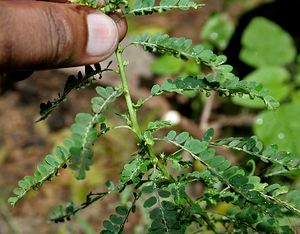Note: This is a project under development. The articles on this wiki are just being initiated and broadly incomplete. You can Help creating new pages.
Phyllanthus amarus - Bhuamlaki
Phyllanthus amarus is widely used as a medicinal plant Ayurvedic medicine. An infusion is considered a good tonic, diuretic and antipyretic. A decoction of the aerial parts or only of the leaves is taken to treat gonorrhoea, diarrhoea, dysentery, stomach-ache, pain in the sides, haemorrhoids and absence of menstruation or female sterility. A suppository of the leaf paste is applied to the vagina to treat absence of menstruation and polyps. Leaf sap, mixed with palm oil or not, is applied as ear drops to treat otitis and applied to abscesses, sores and wounds.[1]
Uses
Parts Used
Chemical Composition
Seed contains anthraquinones,namely; (aurantio-obtusin, chryso-obtusin,obtusin, chrysoobtusin-2-O-beta-glucoside,physcion,emodin,chrysophanol,obtusifolin,obtusifolin-2-O-beta-D-glucoside, alaternin 2-O-β-Dglucopyranoside)15, brassinosteroids(brassinolide, castasterone, typhasterol,teasterone, and 28-norcastasterone), andmonoglycerides (monopalmitin andmonoolein)16. Phenolic glycosides such asrubrofusarin triglucoside, nor-rubrofusaringentiobioside, demethylflavasperone gentiobioside, torachrysone gentiobioside,torachrysone tetraglucoside and torachrysoneapioglucoside were also isolated 17[2]
Common names
| Language | Common name |
|---|---|
| Kannada | āvarike |
| Hindi | Tarwar |
| Malayalam | |
| Tamil | āvārai |
| Telugu | taṃgēḍu |
| Marathi | NA |
| Gujarathi | NA |
| Punjabi | NA |
| Kashmiri | NA |
| Sanskrit | Aaavartaki |
| English | Avaram senna |
Habit
Identification
Leaf
| Kind | Shape | Feature |
|---|---|---|
| alternate | elliptic to oblong | Each branch has 12-32 leaves. The leaves are elliptic to oblong, to 1.5 cm (usually smaller), with an entire margin and with a rounded or apiculate leaf apex |
Flower
| Type | Size | Color and composition | Stamen | More information |
|---|---|---|---|---|
| bisexual | 2.5 cm long | bright yellow | 5-20 | The racemes are few-flowered, short, erect, crowded in axils of upper leaves so as to form a large terminal inflorescence stamens barren; the ovary is superior, unilocular, with marginal ovules. |
Fruit
| Type | Size | Mass | Appearance | Seeds | More information |
|---|---|---|---|---|---|
| short legume | 7.5–11 cm long, 1.5 cm broad | clearly grooved lengthwise, Lowest hooked hairs aligned towards crown | oblong, obtuse, tipped with long style base, flat, thin, papery, undulately crimpled, pilose, pale brown. | 12-20 seeds | {{{6}}} |
Other features
List of Ayurvedic medicine in which the herb is used
- Vishatinduka Taila as root juice extract
Where to get the saplings
Mode of Propagation
How to plant/cultivate
Requires a sunny position. Sandy loam and black soils with a pH of 7.5 - 8 are considered best[4]
Commonly seen growing in areas
Photo Gallery
References
- ↑ Cite error: Invalid
<ref>tag; no text was provided for refs nameduses - ↑ "Pharmacological"
- ↑ "eol.ord"
- ↑ "trophical plants"
External Links
- Pages with reference errors
- Pages that are stubs
- Ayurvedic Herbs known to be helpful to treat rheumatism
- Ayurvedic Herbs known to be helpful to treat eye diseases
- Ayurvedic Herbs known to be helpful to treat gonorrhea
- Ayurvedic Herbs known to be helpful to treat diabetes
- Ayurvedic Herbs known to be helpful to treat gout
- Herbs with Root used in medicine
- Herbs with Bark used in medicine
- Herbs with Leaves used in medicine
- Herbs with common name in Kannada
- Herbs with common name in Hindi
- Herbs with common name in Tamil
- Herbs with common name in Telugu
- Herbs with common name in Sanskrit
- Herbs with common name in English
- Habit - annual herb
- Index of Plants which can be propagated by Seeds
- Herbs that are commonly seen in the region of tropical
- Herbs that are commonly seen in the region of subtropical
- Herbs that are commonly seen in the region of drained sandy -loam soil
- Herbs



